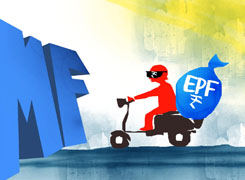40-Year-Old With 2.5 Lakhs Monthly Savings: How Much for Retirement?
Ramalingam Kalirajan |7379 Answers |Ask -Follow
Mutual Funds, Financial Planning Expert - Answered on Jul 16, 2024
He has an MBA in finance from the University of Madras and is a certified financial planner.
He is the director and chief financial planner at Holistic Investment, a Chennai-based firm that offers financial planning and wealth management advice.... more

Hi, I am 40 years old, stay with wife , no kids. My monthly take home salary is 1,00,000. I have yearly contributions towards Tax saver mutual funds of 1,20,000. PPF of 30,000 and NPS of 50,000. Investment towards non tax saver mutual funds of 36,000 for last 3 years. 23,000 is my rent and 50,000 is my monthly family expense. I have a house in my native where my mother stay with approx valuation of 50L. Wife has a plot in her native which is priced 1Cr as of today. Please suggest what should be my retirement corpus and how to achieve the same.
Tax Saver Mutual Funds: Rs. 1,20,000
PPF: Rs. 30,000
NPS: Rs. 50,000
Non-Tax Saver Mutual Funds: Rs. 36,000
Your monthly expenses are:
Rent: Rs. 23,000
Family Expenses: Rs. 50,000
Evaluating Existing Investments
Your current investments in tax saver and non-tax saver mutual funds, PPF, and NPS are good. These will help build your retirement corpus over time.
Estimating Retirement Corpus
Assume you plan to retire at 60 and live till 85. You need a retirement corpus to cover 25 years. Considering inflation and current expenses, your retirement corpus should be substantial.
Steps to Achieve Retirement Corpus
Increase Monthly Savings: You have Rs. 27,000 left after expenses. Allocate this to your retirement savings.
Diversify Investments: Continue investing in mutual funds and NPS. Consider increasing your SIP amounts gradually.
Review and Adjust Investments: Regularly review your portfolio. Adjust based on market conditions and financial goals.
Consider Health Insurance: Ensure you have adequate health insurance. This protects your savings from medical emergencies.
Emergency Fund: Maintain an emergency fund. This should cover 6-12 months of expenses.
Property Valuation
Your house and wife's plot are significant assets. Though not recommended for real estate investment, they provide financial security.
Final Insights
You are on the right track with diversified investments. Increase your savings, review regularly, and ensure you are covered for emergencies. This will help you achieve a secure retirement.
Best Regards,
K. Ramalingam, MBA, CFP,
Chief Financial Planner,
www.holisticinvestment.in
You may like to see similar questions and answers below
Ramalingam Kalirajan |7379 Answers |Ask -Follow
Mutual Funds, Financial Planning Expert - Answered on Nov 04, 2024
Ramalingam Kalirajan |7379 Answers |Ask -Follow
Mutual Funds, Financial Planning Expert - Answered on Nov 04, 2024
Mihir Tanna |979 Answers |Ask -Follow
Tax Expert - Answered on Jan 01, 2025
Mihir Tanna |979 Answers |Ask -Follow
Tax Expert - Answered on Jan 01, 2025
T S Khurana |272 Answers |Ask -Follow
Tax Expert - Answered on Jan 01, 2025
T S Khurana |272 Answers |Ask -Follow
Tax Expert - Answered on Jan 01, 2025
Nayagam P P |4018 Answers |Ask -Follow
Career Counsellor - Answered on Jan 01, 2025
Nayagam P P |4018 Answers |Ask -Follow
Career Counsellor - Answered on Jan 01, 2025
Dr Nagarajan Jsk |195 Answers |Ask -Follow
NEET, Medical, Pharmacy Careers - Answered on Dec 31, 2024
Nitin Narkhede |43 Answers |Ask -Follow
MF, PF Expert - Answered on Dec 31, 2024
Nitin Narkhede |43 Answers |Ask -Follow
MF, PF Expert - Answered on Dec 31, 2024
Nitin Narkhede |43 Answers |Ask -Follow
MF, PF Expert - Answered on Dec 31, 2024























